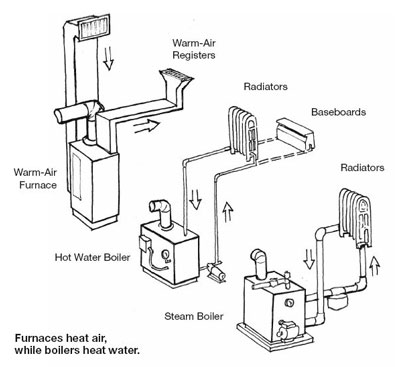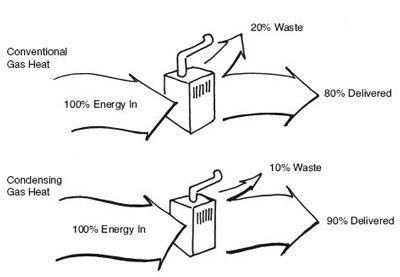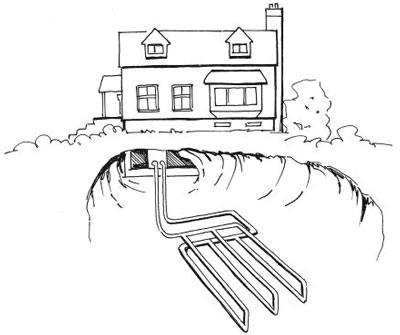How To Remove Air From Hot Water Heating System
Central Rut
Furnaces
The majority of North American households depend on a primal furnace to provide heat. A furnace works by blowing heated air through ducts that evangelize the warm air to rooms throughout the house via air registers or grills. This type of heating system is called a ducted warm-air or forced warm-air distribution arrangement. Information technology tin can be powered by electricity, natural gas, or fuel oil.
Inside a gas- or oil-fired furnace, the fuel is mixed with air and burned. The flames heat a metal oestrus exchanger where the rut is transferred to air. Air is pushed through the oestrus exchanger by the "air handler's" furnace fan and and then forced through the ductwork downstream of the estrus exchanger. At the furnace, combustion products are vented out of the building through a flue pipe. Older "atmospheric" furnaces vented directly to the atmosphere, and wasted about 30% of the fuel energy just to continue the exhaust hot enough to safely rise through the chimney. Electric current minimum-efficiency furnaces reduce this waste substantially by using an "inducer" fan to pull the exhaust gases through the rut exchanger and induce draft in the chimney. "Condensing" furnaces are designed to reclaim much of this escaping heat by cooling frazzle gases well beneath 140°F, where water vapor in the frazzle condenses into h2o. This is the primary feature of a high-efficiency furnace (or boiler). These typically vent through a sidewall with a plastic pipe.

New furnace standards are currently under development by the U.Due south. Department of Free energy, and are due to exist finalized in the spring of 2022. The current furnace standards take not been updated since 1987.
Heating organisation controls regulate when the various components of the heating organisation plough on and off. The nearly important control from your standpoint is the thermostat, which turns the system — or at least the distribution system — on and off to continue you comfortable. A typical forced air system volition have a unmarried thermostat. Just, there are other internal controls in a heating arrangement, such as "high limit" switches that are part of an invisible but disquisitional fix of safety controls.

The all-time gas furnaces and boilers today take efficiencies over 90%
The efficiency of a fossil-fuel furnace or boiler is a measure of the amount of useful rut produced per unit of input free energy (fuel). Combustion efficiency is the simplest measure; it is only the system's efficiency while it is running. Combustion efficiency is like the miles per gallon your automobile gets cruising along at 55 miles per hour on the highway.
In the U.Southward., furnace efficiency is regulated past minimum AFUE (Almanac Fuel Utilization Efficiency). AFUE estimates seasonal efficiency, averaging peak and office-load situations. AFUE accounts for first-up, cool-down, and other operating losses that occur in real operating weather, and includes an approximate of electricity used by the air handler, inducer fan, and controls. AFUE is similar your motorcar mileage between fill-ups, including both highway driving and stop-and-go traffic. The higher the AFUE, the more efficient the furnace or boiler.
Boilers
Boilers are special-purpose h2o heaters. While furnaces bear rut in warm air, boiler systems distribute the rut in hot water, which gives up oestrus as it passes through radiators or other devices in rooms throughout the house. The cooler water then returns to the boiler to be reheated. Hot water systems are frequently called hydronic systems. Residential boilers mostly use natural gas or heating oil for fuel.
In steam boilers, which are much less common in homes today, the water is boiled and steam carries heat through the house, condensing to water in the radiators as information technology cools. Oil and natural gas are commonly used.
Instead of a fan and duct system, a boiler uses a pump to circulate hot water through pipes to radiators. Some hot water systems broadcast water through plastic tubing in the flooring, a organisation called radiant floor heating (see "State of the Fine art Heating"). Of import boiler controls include thermostats, aquastats, and valves that regulate circulation and water temperature. Although the cost is not footling, it is generally much easier to install "zone" thermostats and controls for individual rooms with a hydronic system than with forced air. Some controls are standard features in new boilers, while others can be added on to salve free energy (see the "Modifications by Heating System Technicians" department on the heating maintenance page).
As with furnaces, condensing gas-fired boilers are relatively common, and significantly more efficient than non-condensing boilers (unless very sophisticated controls are employed). Oil-fired condensing boilers are uncommon in the U.Southward. for several reasons related to lower latent heat potential, and potential for greater fouling with conventional fuel oil.
Heat Pumps
Heat pumps are but ii-mode air conditioners (run into detailed description in the cooling systems section). During the summertime, an air conditioner works by moving rut from the relatively cool indoors to the relatively warm exterior. In wintertime, the heat pump reverses this trick, scavenging oestrus from the cold outdoors with the help of an electric system, and discharging that rut inside the house. Near all heat pumps use forced warm-air commitment systems to move heated air throughout the house.

A ground-source rut pump heats and cools in any climate by exchanging heat with the footing, which has a more than constant temperature.
There are ii relatively common types of heat pumps. Air-source heat pumps utilise the outside air as the oestrus source in winter and rut sink in summer. Ground-source (also chosen geothermal, GeoExchange, or GX) rut pumps go their heat from underground, where temperatures are more constant year-round. Air-source heat pumps are far more than common than ground-source heat pumps because they are cheaper and easier to install. Ground-source heat pumps, however, are much more efficient, and are frequently chosen past consumers who plan to remain in the aforementioned firm for a long fourth dimension, or have a strong desire to alive more sustainably. How to decide whether a heat pump makes sense in your climate is discussed further under "Fuel Options."
Whereas an air-source heat pump is installed much similar a key air conditioner, footing-source oestrus pumps require that a "loop" exist cached in the ground, usually in long, shallow (iii–6' deep) trenches or in one or more vertical boreholes. The particular method used will depend on the experience of the installer, the size of your lot, the subsoil, and the landscape. Alternatively, some systems depict in groundwater and pass information technology through the heat exchanger instead of using a refrigerant. The groundwater is then returned to the aquifer.
Because electricity in a heat pump is used to motility heat rather than to generate it, the oestrus pump can deliver more than energy than it consumes. The ratio of delivered heating free energy to consumed energy is called the coefficient of performance, or COP, with typical values ranging from 1.five to three.5. This is a "steady-state" measure and not straight comparable to the heating season performance factor (HSPF), a seasonal mensurate mandated for rating the heating efficiency of air-source heat pumps. Converting between the measures is not straightforward, but ground-source units are generally more efficient than air-source heat pumps.
Direct Heat
Gas-Fired Space Heaters
In some areas, gas-fired direct heating equipment is popular. This includes wall-mounted, free-continuing, and flooring furnaces, all characterized by their lack of ductwork and relatively small heat output. Because they lack ducts, they are most useful for warming a single room. If heating several rooms is required, either the doors between rooms must exist left open or another heating method is necessary. Better models use "sealed combustion air" systems, with pipes installed through the wall to both provide combustion air and behave off the combustion products. These units can provide acceptable performance, peculiarly for cabins and other buildings where large temperature differences between bedrooms and main rooms are acceptable. The models can be fired with natural gas or propane, and some burn kerosene.
Unvented Gas-Fired Heaters: A Bad Idea
Gas or kerosene space heaters that practice not have an exhaust vent accept been sold for decades, simply we strongly discourage their use for health and safe reasons. Known as "vent-gratis" gas heating appliances by manufacturers, they include wall-mounted and gratis-continuing heaters as well every bit open up-flame gas fireplaces with ceramic logs that are not actually continued to a chimney. Manufacturers merits that because the products' combustion efficiency is very loftier, they are rubber for edifice occupants. Nonetheless, this merits is simply valid if y'all keep a nearby window open for acceptable fresh air— which defeats the purpose of supplemental estrus. Dangers include exposure to combustion past-products, every bit discussed in Ventilation, and oxygen depletion (these heaters must be equipped with oxygen depletion sensors). Because of these hazards, at least 5 states (California, Minnesota, Massachusetts, Montana, and Alaska) prohibit their utilize in homes, and many cities in the United States and Canada accept banned them also.
Electric Space Heaters
Portable (plug-in) electric heaters are cheap to buy, but costly to utilize. These resistive heaters include "oil-filled" and "quartz-infrared" heaters. They convert electrical current from the wall socket directly into heat, like a toaster or clothes atomic number 26. As explained farther under "Selecting a New System," it takes a lot of electricity to evangelize the same amount of useful heat that natural gas or oil tin can provide onsite. A one,500- watt plug-in heater will use virtually the entire chapters of a fifteen-amp branch circuit; thus, adding much additional load will trip the excursion billow or blow the fuse. The toll to operate a one,500-watt unit for an hour is unproblematic to compute: it is ane.5 times your electricity toll in cents per kilowatt-60 minutes. At national average rates—12¢ kWh for electricity— that heater would cost 18¢ per hour to run—and chop-chop cost more than its purchase price. On the other hand, for intermittent employ, information technology is the "to the lowest degree-bad" solution when alternatives would crave major investments to improve ductwork for a specific area, for example. Only remember, electric resistance rut is ordinarily the most expensive class of heat, and information technology is, therefore, seldom recommended.
"Electric baseboard heat" is even so another kind of resistive heating, similar to a plug-in space heater except that information technology is difficult-wired. Information technology has two primary virtues: the installation cost is low, and it is easy to install individual room thermostats so you can turn down the heat in rooms that aren't existence used. Operating costs, as for all resistive systems, are by and large very high, unless the business firm is "super-insulated."
Forest-Burning and Pellet Stoves
Wood heating can make a groovy bargain of sense in rural areas if yous enjoy stacking wood and stoking the stove or furnace. Forest prices are more often than not lower than gas, oil, or electricity. If you lot cut your own woods, the savings can exist large. Pollutants from wood burning have been a problem in some parts of the state, causing the U.Due south. Environmental Protection Agency (EPA) to implement regulations that govern pollution emissions from woods stoves. As a result, new models are quite clean-called-for. Pellet stoves offering a number of advantages over forest stoves. They are less polluting than wood stoves and offer users greater convenience, temperature control, and indoor air quality.
Fireplaces
Gas (and almost wood) fireplaces are basically part of a room's décor, providing a warm glow (and a manner to dispose of secret documents), only typically not an constructive heat source. With customary installations that rely on air drawn from the room into the fireplace for combustion and dilution, the fireplace will generally lose more heat than it provides, because then much warm air is drawn through the unit and must be replaced by cold outside air. On the other hand, if the fireplace is provided with a tight-sealing glass door, a source of outside air, and a practiced chimney damper, it can provide useful heat.
State of the Art Heating
Radiant flooring heat mostly refers to systems that circulate warm water in tubes under the floor. This warms the floor, which in plough warms people using the room. It is highly controllable, considered efficient by its advocates, and is expensive to install. It besides requires a very experienced system designer and installer, and limits carpet choices and other flooring finishes: you don't want to "blanket" your heat source.
Contact the Radiant Console Clan
Ductless, Mini-Split, Multi-Split. Residential ductwork is relatively rare outside North America. "Ductless" heat pumps, which distribute energy through refrigerant lines instead of water or air, are widely used. Big field trials in the Pacific Northwest advise that they can have adept cold weather performance, and be very cost-effective where replacing electric resistance heating. Similar ground-source systems, relative immaturity of the market place helps assure that whole-house multi-carve up systems carry premium prices.
Combined heat and power (CHP) or cogeneration for houses is beingness seriously studied in some countries. The bones premise is to use a small generator to encounter some of the electric need of the house, and recover the waste oestrus (typically more than than 70% of the heating value of the fuel) to heat the firm (hydronic or water-to-air systems) and make domestic hot water. These systems are not yet widely bachelor. They are likely to take the best economics in houses with high heating bills considering the firm cannot be feasibly insulated, such every bit solid stone or brick homes.
Source: https://smarterhouse.org/heating-systems/types-heating-systems
Posted by: robertsgois1936.blogspot.com


0 Response to "How To Remove Air From Hot Water Heating System"
Post a Comment